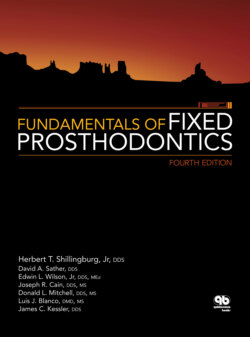Читать книгу Fundamentals of Fixed Prosthodontics - James C. Kessler - Страница 74
Setting condylar guidance
ОглавлениеA hex driver is used to loosen the set screw on the underside of each fossa, and the medial side wall is set to a 6-degree progressive lateral translation. The lock screw on each end of the posterior aspect of the upper crossbar of the articulator is released using a hex driver, and both condylar guides are set at 0 degrees. Then the set screw is loosened on the top of each fossa as far as possible to the medial. The incisal guide pin is lifted to prevent it from touching the plastic incisal stop in any position. The centric latch is released.
The right lateral interocclusal record is seated on the maxillary cast attached to the inverted upper member of the articulator. The teeth should seat completely in the wax indentations. The upper member of the articulator is held in the left hand, and the right condylar element is placed in the right condylar guide. The teeth of the mandibular cast are seated gently but completely into the indentations of the wax record.
One hand is used on the right side of the articulator to support it in this position. The left condylar element will have moved downward, forward, and inward. It should not be touching the condylar guide at any point (Fig 5-49).
The inclination of the right protrusive condylar path is increased by rotating the fossa until the superior wall makes contact with the condylar element (Fig 5-50a). The set screw on the back of the upper crossbar is tightened with a hex driver. The immediate lateral translation is set by moving the medial wall of the fossa outward or laterally until it contacts the medial surface of the condylar element (Fig 5-50b). The set screw is retightened. The wax interocclusal record for the left lateral excursion is used to set the right condylar guidance in the same manner.
Fig 5-49 The right lateral interocclusal record causes the left condyle to move away from the superior wall (a) and the medial wall (b) of the guide.
Fig 5-50 To adjust the condylar guide, the condylar inclination is increased until the superior wall contacts the condyle (a), and the medial wall is moved into contact with the condyle (b).
After the articulator is set, the data is recorded on the patient’s information card. The articulator settings for each side are marked on the respective side of the patient’s cast. For example, a condylar inclination of 35 degrees and an immediate lateral translation of 0.6 mm would be recorded as 35/0.6. When teeth are prepared at a future time, working casts can be mounted on the articulator without making new records. The instrument can be reset using the recorded information from the diagnostic mounting.
